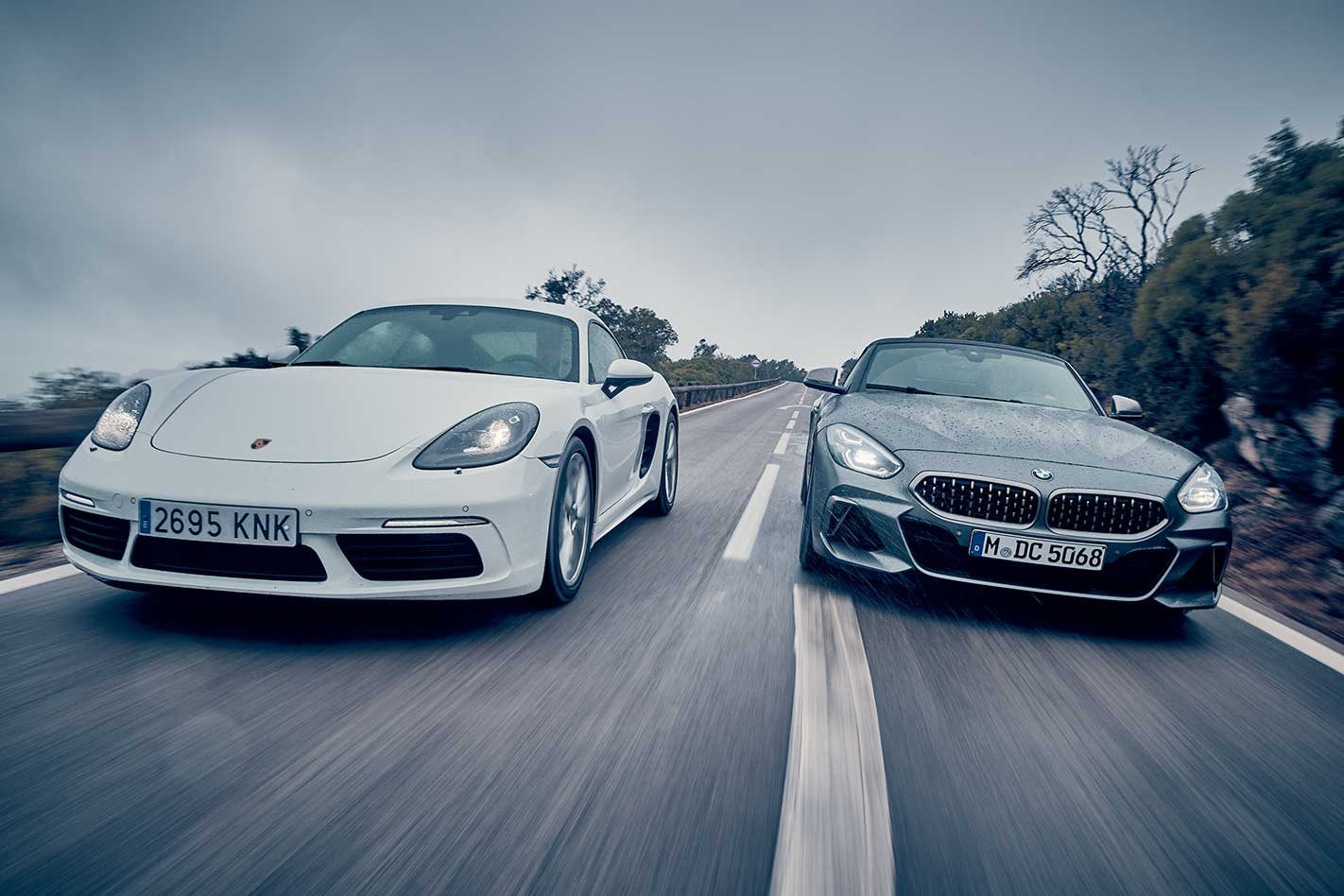Frustratingly, things don’t always go to plan. If they did, we wouldn’t have the all-new BMW Z4 parked next to a Porsche 718 Cayman. And it also wouldn’t be endowed with the meagre 2.0-litre four-cylinder turbo. It is half-a-litre short on capacity and sans the essential topless ability we asked for when trying to secure a Boxster S for this comparison.

Before pressing a starter button, this all seems a bit of a mismatch on paper. However, stats and figures can often mean little out on the open road and, ultimately, the body styles presented don’t tell the full story.
Why would BMW allow us to bring a Porsche Boxster (that was the original aim, remember) to the launch of the new Z4? It’s certainly not as a favour. The red carpet was rolled out for our rival because BMW knew that the G29 Z4 has evolved into a proper sports car.
The original Z4 was an abomination from the Bangle design era, while the second generation was pretty, yet dynamically flawed with the retractable hardtop aimed squarely at the Mercedes-Benz SLK. Although the reality is that this line of ancestors might as well be from another family, because the third generation is a completely different animal.
Want proof? The boosted, 3.0-litre straight-six-powered M40i we have here blitzes the Nordschleife in 7:55.41sec, which is faster than the N55-powered M2 by a decent margin. Additionally, with 250kW and 500Nm, the claimed 0-100km/h time of 4.5sec is as plausible as it is impressive.

It’s no surprise, then, that BMW can’t wait for the M40i to throw down the gauntlet to the 718 Porsche, even if its 220kW/380Nm outputs leave it looking unfairly outgunned (its 4.7sec 0-100km/h time – with Sport Chrono fitted – is further proof). Yet, Stuttgart’s horses are traditionally stronger and more effective than they initially seem, and while the Z4 is limited to 250km/h, the Cayman will push on to 277km/h.
Essentially, the Cayman is to the Boxster what the Toyota Supra is to the Z4. Also developed in Europe, the Supra breathes down the Z4’s neck much harder than is comfortable for the venerable German marque. Not surprisingly, the Cayman does the same thing to the Boxster. So unless you regularly lower the roof, the coupe should always be the driver-orientated choice over the roadster.
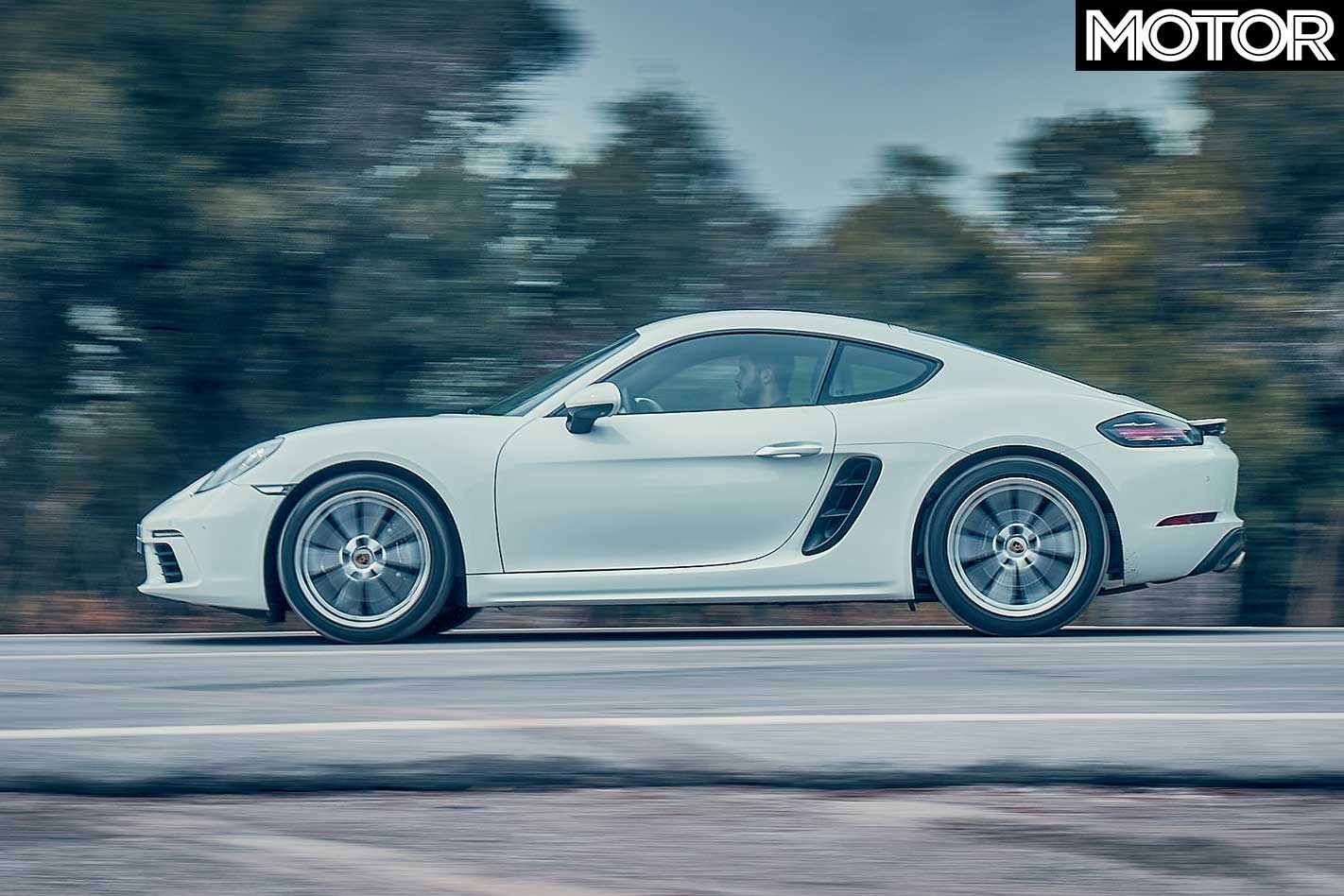
Well, that’s the theory, but in reality the Z4 is much closer to its Japanese counterpart than most would have predicted. “The new Z4 is more puristic, dynamic and progressive than the outgoing model,” says the project leader, Michael Wimbeck. “There is no better roadster to explore empty B-roads early on Sunday morning than the new Z4.” With that said, it’s time to get in the cars and drive.
While the location of Lisbon is idyllic, the weather decides not to play ball. Dense sheets of rain persist as the seemingly drought-breaking precipitation transforms the parched surface into an ice rink. Grip becomes an entertaining illusion as both rear-drive steeds demand to be driven.
Given half a chance the Z4 will fishtail away from the apex, while the Cayman offers a broader scope of understeer and oversteer. Still, the buffer zone between bravery and bad luck can be brutally narrow in these conditions.
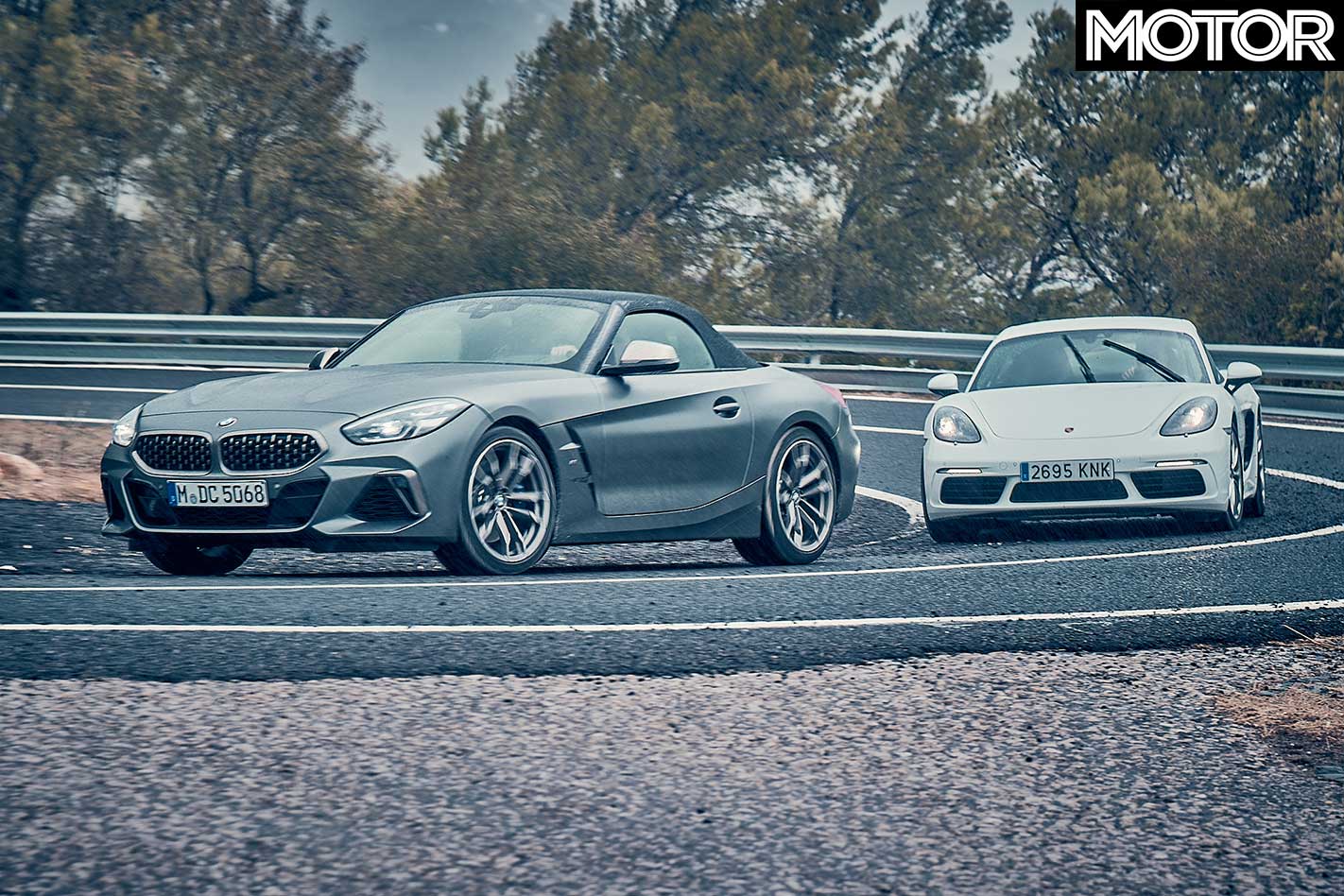
As the rain mercifully clears and the strong winds dry the tarmac, the BMW starts pulling away from the Porsche in small, but quantifiable increments. Its main assets are a torquier and more powerful engine and the commendably rapid eight-speed automatic transmission.
However, it weighs in excess of 1500kg, whereas 1365kg is listed for both the base Cayman and Boxster (the coupe still outperforms the drop-top for torsional rigidity and overall stiffness).
The BMW power unit delivers its 250kW between 5000 and 6500rpm, while the 500Nm torque peak is available from 1600-4500rpm. The flat four needs 6500rpm to churn out its 220kW and the Porsche maintains 380Nm of twist between 2150-4500rpm. You need every extra Newton metre of grunt to take off quickly in the Z4 before pulling away like lightning.
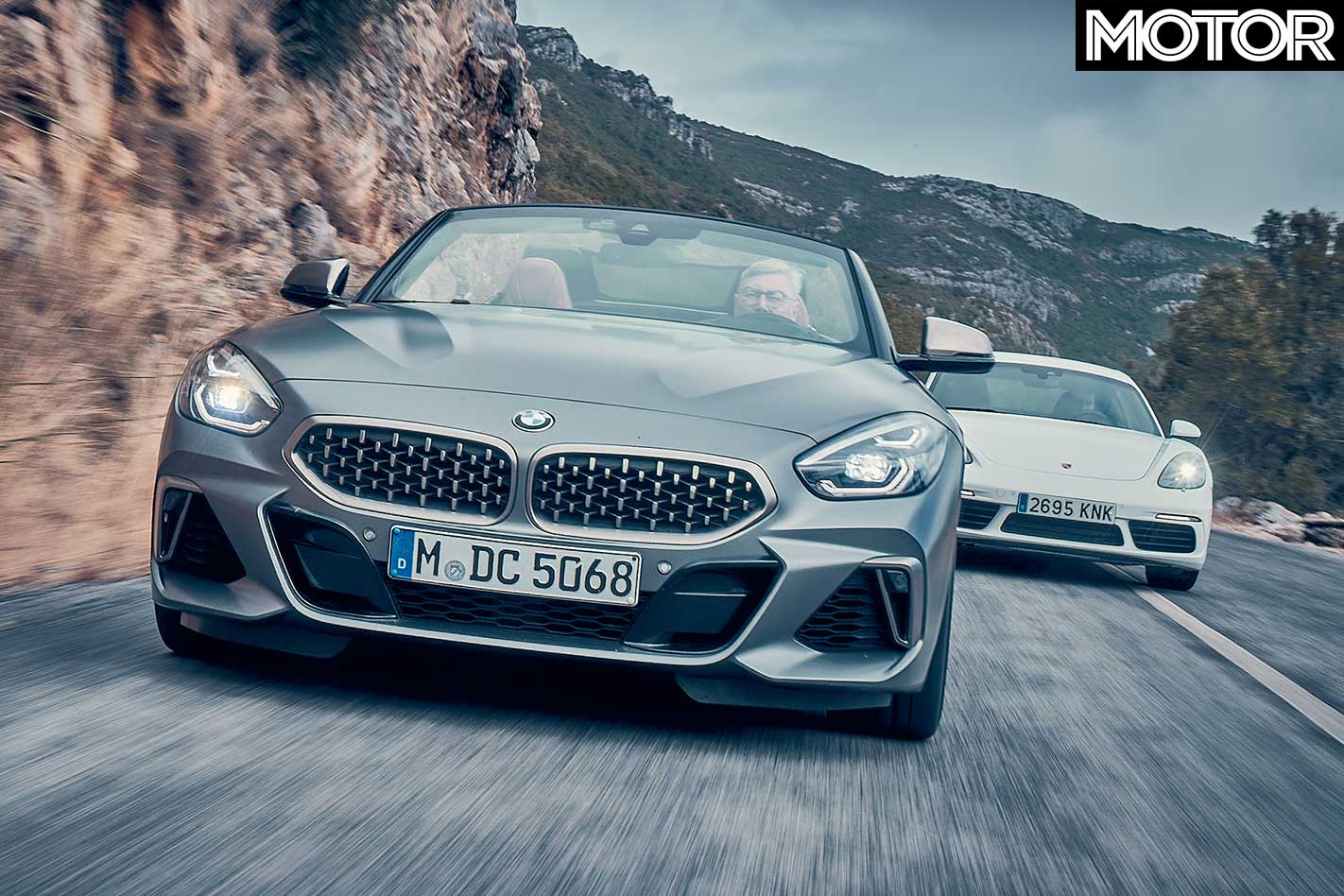
The standard eight-speed auto makes it easy to climb the torque mountain, but it isn’t as quick or as sharp as the optional seven-speed PDK transmission in the Cayman. Without the dual-clutch ’box, the Z4 would easily embarrass the Cayman.
That controversial flat four, the smaller of the two, is better than its questionable reputation. Yet it relies on high revs to deliver and it doesn’t muster quite the same linear punch as a flat six – and it sounds more like an air-cooled Beetle on steroids than a detuned M1. The 220kW, mid-engined Porsche is blatantly entry-level instead of cream of the crop.
For acoustics, the M40i has this comparison licked. Like the lead singer of a metal band, the six-pot melodically intones its trademark theatrics between a bassy low-end to a high-revving crescendo. And it can be enjoyed even more so when topless.

When we first drove an early prototype Z4 at the BMW proving grounds, the roadster impressed with a variety of talents. It worked well as an open-top GT, but we could already feel the potential of what’s underneath.
Blending the relaxed mastery of a cruiser with the hardcore handling of a bruiser is something the M40i is proving extremely capable of. Throttle response, transmission setup, damper variation, steering weight and the electronically controlled diff lock can be tweaked in five different modes. Sport Plus is okay for track use, but Sport is more compliant and, as a result, better suited out on the road.
Fitted with the optional 19-inch alloys, just like the contender from Munich, the Porsche does not ride quite as well as the BMW in Sport mode. In Comfort, things can get a little mushy and undefined. It’s tangibly brittle in Sport Plus, while the steering becomes noticeably heavier and the diff lock trades smoothness for bite. Ultimately, there’s a lot at play, here.
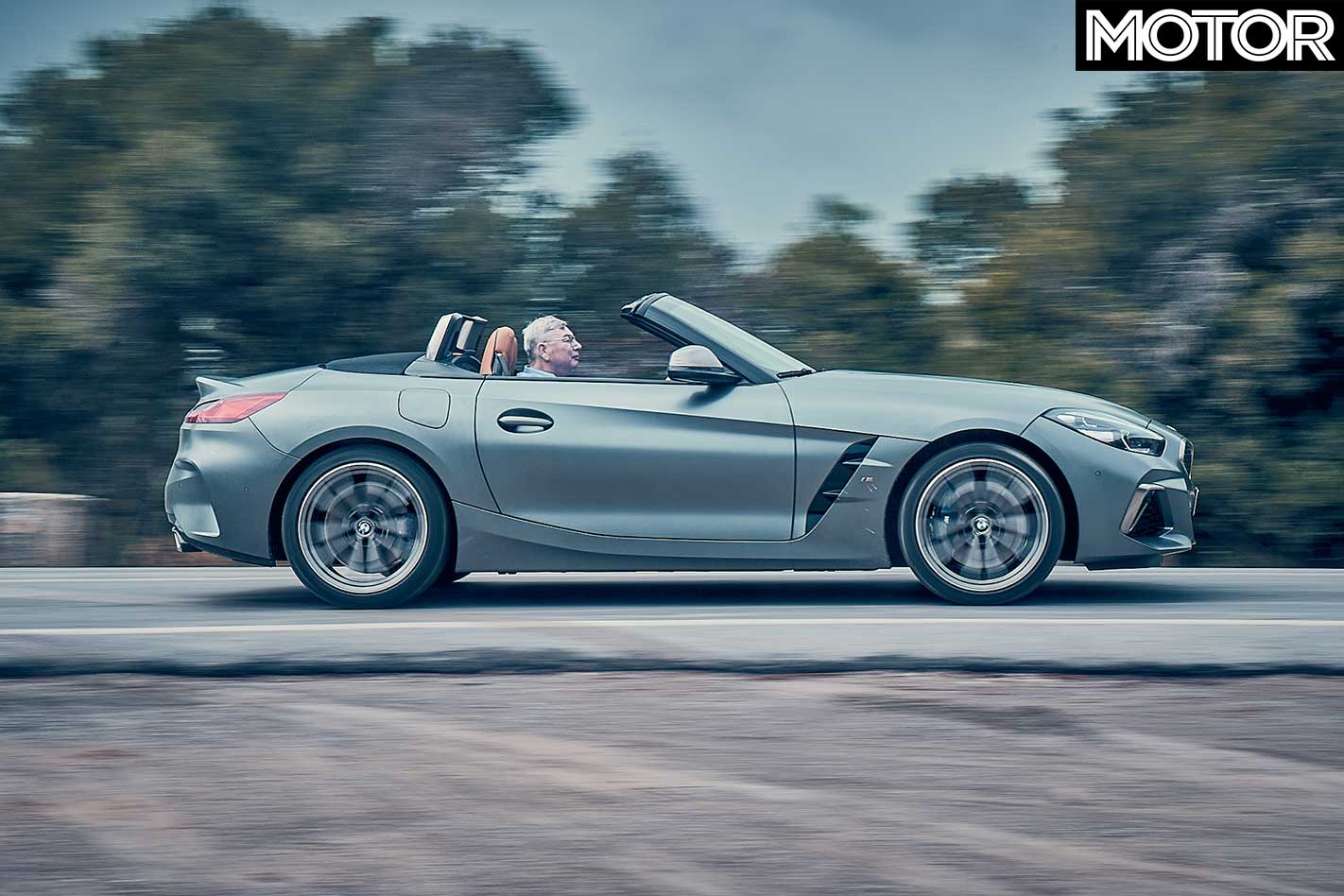
While the overall length has grown, the wheelbase of the new Z4 is actually shorter. It’s a compact drop-top with a sportier DNA, while the Cayman, even in base form, looks and feels like a baby 911. The BMW is easier to drive most of the time. It is fast in a straight line, brakes with proficiency and follows the road accurately. It’s an emotional and exciting bit of kit that also builds confidence quickly.
Helping this is a front-end that sticks like glue, quick turn-in speeds, massive amounts of grip and a rear axle which controls all forces with proficiency and aplomb. BMW has developed a new front axle for the Z4, which will later reappear in the next M4.

What sets the roadster apart from the coupe is the new variable-rate sports steering, which boasts a reassuring meatiness on-centre. There’s more feedback on turn-in and a quicker response during rapid changes of direction.
The 718 Cayman still feels about as competent and challenging as the Z4. Its steering is lighter and even more responsive, while there’s a distinct lack of weight over the engine-less front axle. Grip is its forte, and the heft it saves over the rivalling two-seater adds a dash of nimbleness and agility.
Interestingly, despite the lack of grunt over the twin-scroll turbocharged B58, the flat-four Porsche is every bit as fast as the Z4 through a mountain pass. It allows you to brake a little later and get on the loud pedal earlier, with all the electronic systems seeming to work with you, not against you.

Understeer, and to a lesser degree, oversteer, are potential issues. But no matter what the conditions, the Cayman hangs on vehemently as the amazing turn-in and docile torque delivery aids progress. The Cayman’s steering feels slightly more involving, its brakes are grabbier and a tad stronger, while the uncompromising roadholding prefers smooth surfaces to really shine.
On the inside, the dashboard of the Cayman is starting to look a little dated when pitted against the new Z4. The latter has colourful displays, a practical iDrive controller and sound ergonomic functionality.
The difference between the two infotainment systems seems insurmountable at first – one is more digital (BMW), while the other remains staunchly analogue (Porsche). The Z4’s tech-focused cabin isn’t at the expense of intuition, and in fact, it’s easier to get along with than the old-school buttons in the Cayman.

Still, in the Porsche’s favour are more legible displays, logically arranged buttons and a more advanced voice-control system. Both sorely lack a large display showcasing which gear you’re in, but remain pleasing places to be.
At an estimated $135,000, the 250kW Z4 M40i is about $17K less expensive than the PDK-equipped, 257kW Boxster S we tried to get for this comparison. The 2.0-litre Cayman featured here is $117,132 in base form.
If you’re looking for other options, the Jaguar F-Type V6, Mercedes-AMG SLC43 and the Audi TT RS Cabriolet offer the badge and pace, if not the outright handling prowess, for around the same coin. If a folding roof isn’t a must-have item, then waiting for the new Supra (or indeed the Alpine A110 – which you can buy now), due next year, could be a worthwhile option.
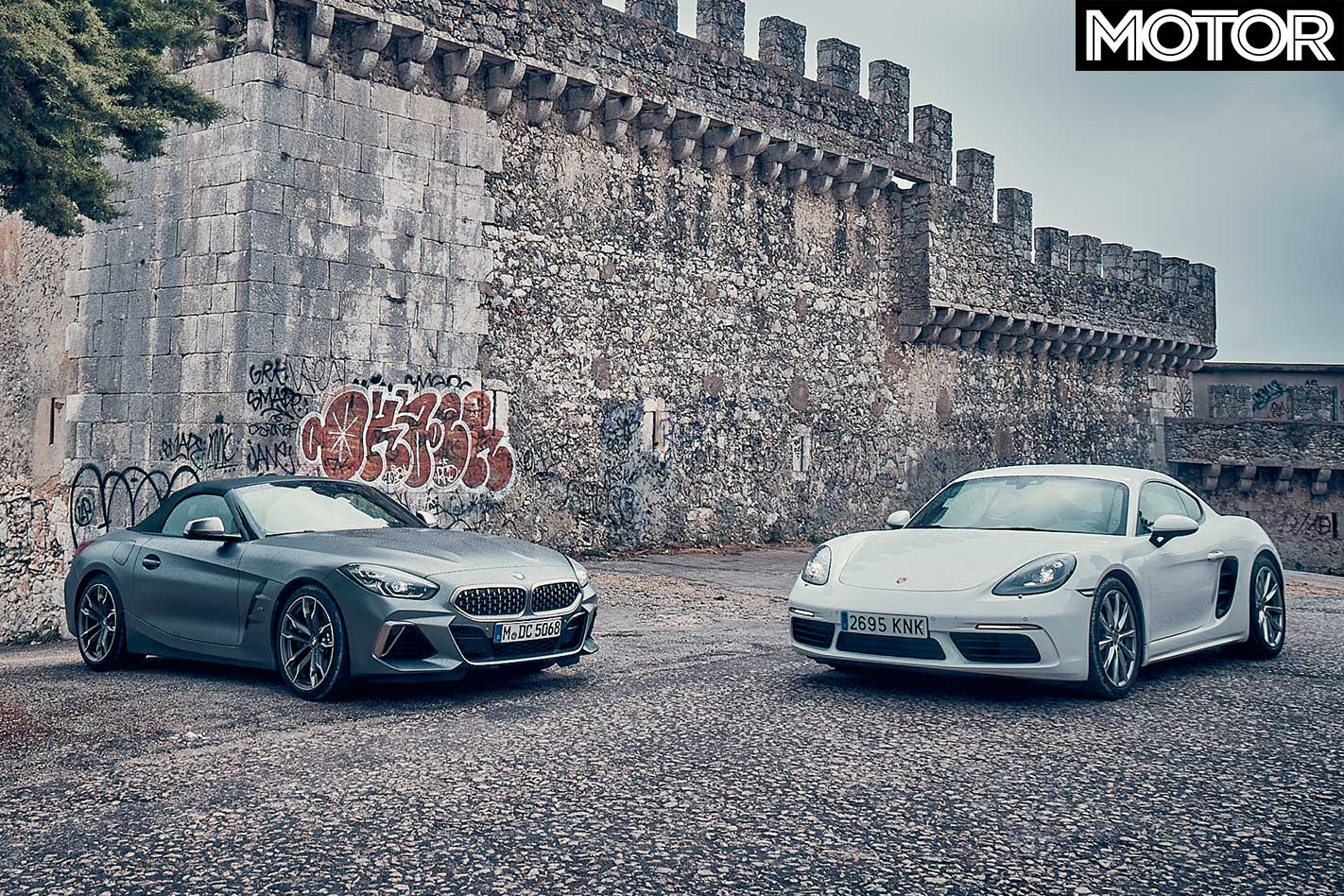
If you fancy the over-styled exterior (to some) and the new interior design, then the Z4 will reward you with a legendary engine, a remarkable chassis and performance that outguns many in this class. It should have been branded a Z5 to underline the model’s transition from poser to professional. A Z4M that’s easily able to outgun an M4 Cabriolet is also a tasty proposition, too.
Shortening the wheelbase and extending the overall length compared to the second-gen car doesn’t seem to make sense until you actually drive the new model. It’s less twitchy at speed, yet more switched on through the twisties. On slippery terrain it’d be nice to override the DSC and power into oversteer, but on dry roads, the grip, traction and roadholding are beyond reproach.
The Cayman has the nicer steering – it’s lighter, quicker and more involving. It also scores with handling characteristics that are more entertaining with an uncanny ability to connect steering, throttle and suspension movements into one compelling experience.

What the Porsche lacks in this company is the extra helping of torque to shove the Cayman forward with vengeance rather than needing to wring its neck for every extra engine revolution. Having less fat and an overall sportier setup, with a rowdier Sport Plus calibration, helps. However, four cylinders and 1988cc simply don’t create as many fireworks as a 2998cc inline-six.
At the end of the day, the Z4 M40i is the faster car. And more often than not, it matches the Cayman for tactile excellence and palpable interaction. For Porsche, the BMW Z4 is now frustratingly close to toppling a car many have regarded as unbeatable. Now that’s certainly going against the plan.
Fast Facts

| u00a0 | Porsche 718 Cayman | BMW Z4 M40i |
| Body | 2-door, 2-seat coupe | 2-door, 2-seat roadster |
| Drive | rear-wheel | |
| Engine | 1988cc flat-4, DOHC, 16v, turbo | 2998cc inline-6, DOHC, 24v, turbo |
| Bore x Stroke | 91.0 x 76.0mm | 94.6 x 82.0mm |
| Compression | 9.5:1 | 11.0:1 |
| Power | 220kW @ 6500rpm | 250kW @ 5000-6500rpm |
| Torque | 380Nm @ 1950-4500rpm | 500Nm @ 1600-4500rpm |
| Power/Weight | 161kW/tonne | 163kW/tonne |
| Transmission | 7-speed dual-clutch | 8-speed automatic |
| Weight | 1365kg | 1535kg |
| Suspension (f) | struts, adaptive dampers, coil springs | |
| Suspension (r) | multi-links, coils, anti-roll bar, adaptive dampers | |
| L/W/h | 4379/1801/1294mm | 4324/1864/1304mm |
| Wheelbase | 2475mm | 2470mm |
| Tracks | 1515/1532mm (f/r) | 1594/1589mm (f/r) |
| Steering | electrically-assisted rack-and-pinion | |
| Brakes (f) | 330mm ventilated discs, 4-piston calipers | 348mm ventilated discs, 4-piston calipers |
| Brakes (r) | 299mm ventilated discs, 4-piston calipers | 345mm ventilated discs, single-piston calipers |
| Wheels | 19.0 x 8.0-inch (f); 19.0 x 10.0-inch (r) | 18.0 x 9.0-inch (f); 18.0 x 10.0-inch (r) |
| Tyre Sizes | 235/40 ZR19 (f); 265/40 ZR19 (r) | 255/40 ZR18 (f); 275/40 ZR18 (r) |
| Tyres | Pirelli P Zero | Michelin Pilot Super Sport |
| Price | $117,132 | $135,000 (est) |
| Pros | Dynamic brilliance; steering response; ample grip; quick-shifting PDK | Newfound pace and handling ability; updated cabin; strong front-end |
| Cons | Controversial soundtrack; needs more grunt; it isnu2019t an S; cabin feeling dated | Weight compared to Cayman; ride quality hard to get right; will be pricey |
| Rating | 4.5 out of 5 stars | 4.5 ouf ot 5 stars |

